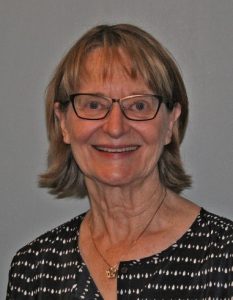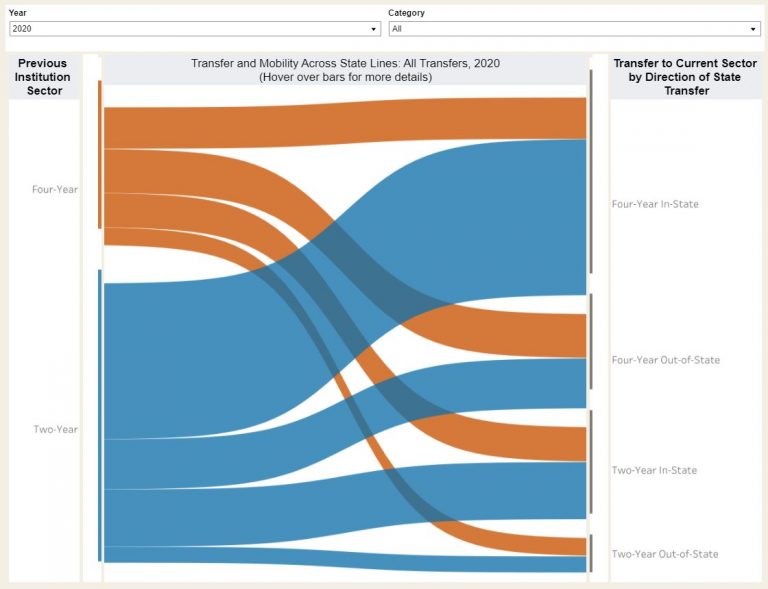Interstate Passport Awarded New Grant!
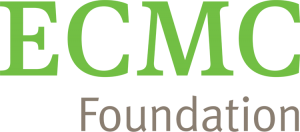 Interstate Passport is pleased to announce that ECMC Foundation has awarded the program a grant of $500,000 to support efforts to scale participation in the Interstate Passport Network. Over the two-year course of this project, staff will recruit and enroll 20 new member institutions, including at least 10 Minority-Serving Institutions, so that more students, particularly students of color and low-income students, will benefit as we continue to build the interstate transfer highway across the nation.
Interstate Passport is pleased to announce that ECMC Foundation has awarded the program a grant of $500,000 to support efforts to scale participation in the Interstate Passport Network. Over the two-year course of this project, staff will recruit and enroll 20 new member institutions, including at least 10 Minority-Serving Institutions, so that more students, particularly students of color and low-income students, will benefit as we continue to build the interstate transfer highway across the nation.
The grant will provide two-year membership subsidies for the 20 new member institutions and allow staff to expand capacity to support new member institutions through the implementation process and ongoing administration. Planning and recruitment activities for this grant began in November 2020. As of January 1, 2021, four institutions have signed letters of intent to join the Interstate Passport Network with support from this grant: Greenville Technical College in Greenville, South Carolina; Miami Dade College in Miami, Florida; Stillman College in Tuscaloosa, Alabama; and Texas A & M University-Central Texas in Killeen, Texas.
If you are interested in joining us or would like to see particular MSIs or other institutions join the Network to support student transfer in and out of your institution, please contact Interstate Passport program manager, Sarah Leibrandt.
Based in Los Angeles, ECMC Foundation seeks to inspire and facilitate improvements that affect educational outcomes – especially among underserved populations – through evidence-based innovation.
New Program Manager Joins Interstate Passport Team
 As part of expanding staff capacity through the ECMC Foundation grant, Interstate Passport is pleased to welcome a new staff member, Dr. Sarah Leibrandt, Ph.D., as Program Manager. Dr. Leibrandt has served as a senior research analyst at the Western Interstate Commission for Higher Education for the past seven years and has over 15 years of experience working in secondary and postsecondary education. Her responsibilities at WICHE have included helping state agencies share education and workforce data with each other through the Multistate Longitudinal Data Exchange as a way to provide better information to students and their families. She most recently led WICHE’s adult learner initiative, Recognizing Learning in the 21st Century, a large-scale research study and landscape analysis of the scaling of prior learning assessment policies and practices. Prior to joining WICHE, Dr. Leibrandt worked for the Colorado Department of Education and Red Rocks Community College. She earned a B.A. in Spanish from Wellesley College and a Ph.D. in Education Policy from the University of Colorado Boulder.
As part of expanding staff capacity through the ECMC Foundation grant, Interstate Passport is pleased to welcome a new staff member, Dr. Sarah Leibrandt, Ph.D., as Program Manager. Dr. Leibrandt has served as a senior research analyst at the Western Interstate Commission for Higher Education for the past seven years and has over 15 years of experience working in secondary and postsecondary education. Her responsibilities at WICHE have included helping state agencies share education and workforce data with each other through the Multistate Longitudinal Data Exchange as a way to provide better information to students and their families. She most recently led WICHE’s adult learner initiative, Recognizing Learning in the 21st Century, a large-scale research study and landscape analysis of the scaling of prior learning assessment policies and practices. Prior to joining WICHE, Dr. Leibrandt worked for the Colorado Department of Education and Red Rocks Community College. She earned a B.A. in Spanish from Wellesley College and a Ph.D. in Education Policy from the University of Colorado Boulder.
Sarah began her role as Interstate Passport Program Manager on December 16, 2020. She will be responsible for the day-to-day operations of Interstate Passport and for helping institutions report data on Passports awarded.
2014 Cohort Added to Student Transfer Destinations Database
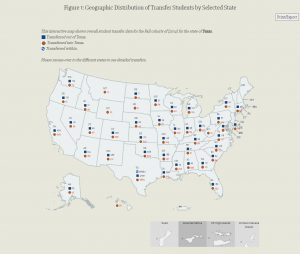 The Student Transfer Destinations by State database, located on the Interstate Passport website, contains transfer data provided by the National Student Clearinghouse Research Center on all 50 states. Data for the 2014 cohort was added to the database this fall, bringing the total number of cohorts to five.
The Student Transfer Destinations by State database, located on the Interstate Passport website, contains transfer data provided by the National Student Clearinghouse Research Center on all 50 states. Data for the 2014 cohort was added to the database this fall, bringing the total number of cohorts to five.
The database contains information on the number of students at public institutions who transferred in the United States and its territories both in state and out of state for the 2006, 2008, 2010, 2012 and 2014 cohorts. Each cohort of students is made up of first-time students of any age who began their postsecondary studies in one of these years. Cohorts include both full-time and part-time students and exclude students who received any degree or certificate from a two- or four-year institution prior to 2006, 2008, 2010, 2012 and 2014, respectively. By design, the data are intended to provide a snapshot of student transfer patterns in the U.S. and its outlying territories. While many students may transfer more than once, this database only tracks the first transfer.
Users are able to query which states their students transferred to, as well as which states incoming students transferred from, and if the sending and receiving institutions are two-year or four-year institutions. Data on in-state transfers are provided as well.
The database is a useful tool to determine patterns of transfer between states that may foster recruitment and cooperative efforts among institutions. NSC reports that 45 percent of transfer students will transfer more than once so the database offers important information to states and institutions on transfer students’ sending institutions or destinations.
Check out the movement of transfer students in your own state here.
Interstate Passport Featured in Upcoming Book Release
 A new book on student transfer published by The Gardner Institute and Stylus Publishing will be released on February 15, 2021. The Transfer Experience: A Handbook for Creating a More Equitable and Successful Postsecondary System goes beyond the limited view of transfer as simply articulating credits. It offers a variety of new perspectives, resources, models, and recommendations, “making the academic, civic, and social justice cases for improving transfer at both transfer-sending and transfer-receiving institutions.” Organized into four parts with 17 chapters penned by researchers, faculty, academic leaders and other experts on transfer from across the country, the handbook covers topics such as “Transfer in Context,” “Pathways, Transitions and Support,” “Teaching and Learning,” and “Transfer in Action.” The book also features an online compendium of 17 case studies, including one on the Interstate Passport written by Patricia Shea, senior advisor. The book is available to order now for delivery in February.
A new book on student transfer published by The Gardner Institute and Stylus Publishing will be released on February 15, 2021. The Transfer Experience: A Handbook for Creating a More Equitable and Successful Postsecondary System goes beyond the limited view of transfer as simply articulating credits. It offers a variety of new perspectives, resources, models, and recommendations, “making the academic, civic, and social justice cases for improving transfer at both transfer-sending and transfer-receiving institutions.” Organized into four parts with 17 chapters penned by researchers, faculty, academic leaders and other experts on transfer from across the country, the handbook covers topics such as “Transfer in Context,” “Pathways, Transitions and Support,” “Teaching and Learning,” and “Transfer in Action.” The book also features an online compendium of 17 case studies, including one on the Interstate Passport written by Patricia Shea, senior advisor. The book is available to order now for delivery in February.
Workplace Competencies via the Interstate Passport
Written by Jane Sherman, Interstate Passport Consultant
We have long known that employers are looking more for important general skills and knowledge – i.e., competencies – in the employees they hire and promote than for specific occupational expertise (AACU, 2011).
Workplace Basics: The Competencies Employers Want, a new report from Anthony Carnevale and associates at Georgetown University, goes farther than earlier reports by including analyzing both general- and occupation-specific cognitive and physical competencies across the following nine different occupational areas:
- Science, Technology, Engineering, and Mathematics
- Managerial and Professional Office
- Healthcare Professional and Technical
- Education
- Community Service and Arts
- Blue-Collar
- Sales and Office Support
- Food and Personal Services
- Healthcare Support
The report delves into the relative remunerative benefits of how intensely the highest rated competencies are utilized across each of the following nine broad occupational areas. For each of the occupational areas surveyed, the report also ranks the intensity with which the highest rated competencies are utilized at each education level: bachelor’s degree or higher; some college or associate’s degree; high school diploma or less.
The key finding from the Georgetown report is that “in the modern labor market, five cognitive competencies are in high demand across all occupational groups: (1) communication, (2) teamwork, (3) sales and customer service,* (4) leadership, and (5) problem-solving and complex thinking. Among the five. . . communication is dominant. . . and is associated with the highest earnings boosts across the labor market.”

What can this perspective contribute to our understanding of the value of Interstate Passport to students, institutions, and employers? Carnevale, et al. urge educators to “provide a curriculum that conveys both general and specific competencies” including those “associated with a general education in the liberal arts and sciences.” Employers are encouraged to more directly “make the case for education and workforce preparation that conveys the competencies that are in high demand.” And the authors call for policymakers to “support programs that allow students and workers to develop high-demand, high-reward competencies, particularly when they improve opportunity for underserved populations.” However, surveys have shown that employers do not believe that transcripts convey helpful information about graduates’ competencies (AACU, 2011).
Earning a Passport is intended to attest that a student has accomplished a general education level of achievement in the highly desired competencies found by Carnevale, et al., along with the competencies “associated with a general education in the liberal arts and sciences.” The Passport Learning Outcomes in each of the nine Passport learning areas define for students, employers, and policymakers the skills and knowledge that students who have earned a Passport will have achieved and can be expected to utilize when they enter the workforce.
For that reason, Interstate Passport can be an ideal vehicle to communicate to students, employers, and policymakers the high-demand cognitive competencies, along with general competencies in the liberal arts and sciences, that Passport earners will bring to their employment and further education. To serve this purpose, a Passport must be recognized as more than a notation at the bottom of a transcript. Rather, it must be widely known as successfully translating into a common language the many diverse approaches toward a common goal: students who have achieved the cognitive competencies and the liberal arts and sciences outcomes to be productive participants in the economy.
*Traditionally, sales and customer service might not rise to such a broad level of desirability, but here this competency specifically includes the ability to assess and meet the needs of customers/clients, but presumably more broadly also of patients/students/co-workers and employers.
References
Valid Assessment of Learning in Undergraduate Education (Project), Liberal Education and America’s Promise (Program), & Association of American Colleges and Universities. (2011). The LEAP vision for learning: Outcomes, practices, impact, and employers’ views. Washington, DC: Association of American Colleges and Universities.
Anthony Carnevale, Megan L. Fasules, and Kathryn Peltier Campbell. (2020). Workplace Basics: The Competencies Employers Want . Washington, DC: Georgetown University Center on Education and the Workforce.
Meet Leila Shimokawa, Director of Communications at University of Hawaiʻi-West Oʻahu
 Leila Shimokawa is the Director of Communications at the University of Hawaiʻi-West Oʻahu where she is responsible for developing and implementing the campus’ strategic communications plan and overseeing crisis and emergency communications. UH West Oʻahu has an enrollment of 3,100 students and Leila works closely with the student affairs team to get messages to students on any topic or issue. “The campus is very collaborative and everyone works closely together,” says Leila. “It’s very much a team effort.”
Leila Shimokawa is the Director of Communications at the University of Hawaiʻi-West Oʻahu where she is responsible for developing and implementing the campus’ strategic communications plan and overseeing crisis and emergency communications. UH West Oʻahu has an enrollment of 3,100 students and Leila works closely with the student affairs team to get messages to students on any topic or issue. “The campus is very collaborative and everyone works closely together,” says Leila. “It’s very much a team effort.”
Shimokawa also serves as chair of the Interstate Passport Campus Marketing/Communications Advisory Committee, which meets several times per year to share ideas, discuss concerns, identify strategies, and agree on recommendations for all campus marketing and communications representatives at Network member institutions. Additionally, she oversees communication about Interstate Passport on the UH West Oʻahu website and in the campus catalog and consults with other campus Network representatives on any issues of concern or recommendations from program staff.
UH West Oʻahu is one of the founding institutions of the Interstate Passport program. Faculty, registrars, and other campus representatives from UH West Oʻahu have been involved with developing and implementing Passport procedures since 2011, and awarding Passports since 2016. Leila noted that each person and department working on Interstate Passport has a good understanding of what the program is, how it benefits students, and what their responsibilities are. According to Shimokawa, Alan Rosenfeld, the UH West Oʻahu Passport Institutional Liaison, “really cemented the Interstate Passport on campus, making sure people were doing what they’re supposed to do and making sure channels of communication are open.”
The University of Hawaiʻi System had very good articulation practices between institutions before joining the Interstate Passport Network, which made integrating Interstate Passport fairly smooth. This year all 10 institutions in the system became members of the Interstate Passport Network, which means that Hawaiʻi students who earn a Passport and transfer to mainland schools will have an advantage in getting credits accepted. The Passport State Transfers by Destination database shows that students from Hawai’i transfer primarily to Western states – California, Washington, Oregon, Colorado and Arizona.
Hawaiʻi has not experienced the chaos of the COVID pandemic to the same extent as other states, but even so, Shimokawa reported that more than 90 percent of UH West Oʻahu classes have been conducted virtually this fall.
COVID-19: Transfer, Mobility, and Progress, Final Fall 2020 Report
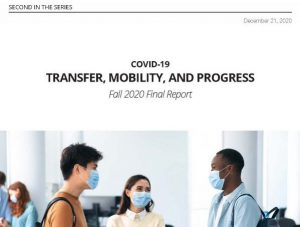 The National Student Clearinghouse (NSC) recently released the second report in a series on the impact of the COVID-19 pandemic on student transfer and mobility. This report presents a more complete picture of fall 2020 transfer patterns and shows sharp declines in enrollment and student mobility. As in the first report that came out this fall, NSC tracked the transfer and mobility pathways of students who enrolled in fall 2020, focusing on three student groups: first-time students; returning students (those who had a stop-out without undergraduate completion and re-enrolled in the current term); and continuing students (those who continued enrollment from the preceding term, with or without having earned an associate degree or certificate). Transfer and mobility were tracked across institutions, sectors, and states, including over summer terms and after a lapse of enrollment. The report shows that the decline in student transfer and mobility is “steep and widespread,” with significant demographic disparities.
The National Student Clearinghouse (NSC) recently released the second report in a series on the impact of the COVID-19 pandemic on student transfer and mobility. This report presents a more complete picture of fall 2020 transfer patterns and shows sharp declines in enrollment and student mobility. As in the first report that came out this fall, NSC tracked the transfer and mobility pathways of students who enrolled in fall 2020, focusing on three student groups: first-time students; returning students (those who had a stop-out without undergraduate completion and re-enrolled in the current term); and continuing students (those who continued enrollment from the preceding term, with or without having earned an associate degree or certificate). Transfer and mobility were tracked across institutions, sectors, and states, including over summer terms and after a lapse of enrollment. The report shows that the decline in student transfer and mobility is “steep and widespread,” with significant demographic disparities.
Report Highlights:*
- Fall transfer student enrollment fell 8.1 percent over last year, more than triple the drop in non-transfer students this fall (-2.4 percent).
- Student mobility fell across all transfer pathways. Reverse transfers decreased the most (19.4 percent), followed by lateral transfers (-12.6 percent) and upward transfers (-0.7 percent).
- Community colleges saw an 18.5 percent drop in freshmen, a 19.6 percent decline in reverse transfers, an 18.7 percent drop in returning students, and 7.2 percent fewer continuing students.
- Four-year colleges experienced relatively smaller declines in transfer enrollment as well as overall enrollment during the pandemic.
- Black and Hispanic transfer students have been impacted the most, particularly at community colleges, whereas Asian students made gains in the four-year college sector.
- Male student mobility declined sharply during the pandemic, regardless of age.
- While fewer students re-enrolled this fall after a stop-out, more opted for primarily online institutions this fall than they did pre-pandemic.
*Source: Causey, J., Harnack-Eber, A., Lang, R., Liu, Q., Ryu, M., and Shapiro, D. (December 2020), COVID-19 Transfer, Mobility, and Progress, Report No. 2, Herndon, VA: National Student Clearinghouse Research Center.
The PDF version of this report is available here: https://nscresearchcenter.org/wp-content/uploads/Covid19-TransferMobilityProgress-FinalFall2020.pdf.
NCS plans to release the third report in the series, with the first snapshot of Spring 2021 patterns, in March 2021.
Transfer In The News
How colleges are reenrolling stopped-out students during the pandemic
By Natalie Schwartz, Higher Ed Dive, November 23, 2020
A number of higher education institutions across the country have been reaching out to students who had stopped out of their degree program to encourage them to re-enroll and finish via online learning. Roughly 36 million adults in the United States have college credits but no degree. According to the article, “online learning is helping some colleges and organizations make inroads with this population despite the pandemic.” Students drop out or stop out of school for a myriad of reasons, so institutions must take that into account when students re-enroll. Some of the incentives that schools are offering include: financial aid, lower tuition, support from coaches and advisors, or credit for prior learning assessments. Many institutions began these efforts before the pandemic, but re-enrollment has remained steady this semester as students need to upgrade skills or simply, finally, finish that degree.
Why Don’t Students Graduate on Time?
By Allegra Lubar, Vemo Education, November 19, 2020
This essay examines various factors that contribute to delayed graduation. In addition to financial reasons – a significant and common problem – “transferring, working, changing majors, juggling too many obligations, and failing to forge social connections at school” are obstacles for many students. They prevent students from taking a full course load, which is “crucial for on-time graduation.” Institutions can help students understand the scope of the problem through public campaigns that encourage full course loads and why students will benefit (on-time graduation, entering the workforce sooner, less money spent on tuition, and thus, perhaps, less money owed in student loans). Institutions can also provide financial aid to students through pay-for-success programs like income-share agreements and expanded career services.
College completion rate stays flat: report
By Hallie Busta, Higher Ed Dive, Pearson, December 3, 2020
This short summary of data reported by the National Student Clearinghouse highlights the slowing rate of college completion across the U.S. Data is reported on the six-year graduation rates of undergraduate learners who started in the fall of 2014, including transfers; the completion data was collected through June 2020. The changes have been slight and not all students and institutions are experiencing the trend in the same way. Community colleges reported a 0.5 percentage point decrease in completion after two years of growth; drops at two-year schools were steepest among Black and Hispanic students. However, completion rates for Black students at public four-year colleges increased by one percentage point. Black men in particular had the biggest decrease in stop-out rates. The COVID pandemic has hit two-year public schools hardest, and fewer undergraduates are attending all U.S. colleges this fall – factors that will continue to slow completion rates.
More California community college students are taking transfer-level courses, but critics say colleges must do more
By Michael Burke, EdSource, December 8, 2020
Two new reports examine the outcomes of legislation passed in 2017 in the state of California – AB 705 – which was intended to boost community college completion rates by allowing students access to transfer-level courses without first taking remedial classes. Studies have shown that students placed in remedial classes, primarily English and math, rarely go on to complete degrees or earn certificates, yet many of them likely could have passed transfer-level classes if allowed access. A new report from the Public Policy Institute of California shows that the law, which went fully into effect last fall, has indeed increased the number of students who enroll in transfer-level courses, and has also narrowed gaps between white students and students of color in accessing transfer-level English and math courses. Despite this progress, over half of the state’s degree-granting community colleges still offer remedial introductory math courses; only three offered no remedial math courses this semester. By law, students cannot be denied access to transfer-level courses, but if remedial courses are their first option, the standard of the law is being violated. The Public Policy Institute of California and the California Acceleration Project, which advocates for eliminating remedial classes altogether to increase completion rates, analyze results and compliance with the new law in the following new reports.
- Public Policy Institute of California, A New Era of Student Access at California’s Community Colleges.
- California Acceleration Project, Still Getting There: How California’s AB 705 Is (and is not) Transforming Community College Remediation and What Needs to Come Next.
What community colleges can teach higher ed about supporting students during and beyond the pandemic
By Xueli Wang, Inside Higher Ed, November 18, 2020
This opinion piece draws from a longitudinal study cohort that the author has followed for six years. She recently conducted interviews of 30 students from that cohort on their community college experiences in the wake of the COVID-19 pandemic. Wang contends that community colleges “are sites of agile adaptation and innovation, perpetually responsive to emerging societal needs.” Students praised their colleges for their focus on the following factors:
- Practicality of training and research capacity
- Technology and communication skills in virtual formats
- Cultivating resilience
- Diversity as a highlight of education
- An education for the community.
Wang offers all higher education institutions three takeaways gleaned from her research:
- Build a stronger curriculum to help students thrive in crisis and a rapidly changing world.
- Establish more purposeful, meaningful and structured opportunities for students to engage with their community.
- Encourage support-seeking and cultivate multiple levels of connection.
Xueli Wang is the Barbara and Glenn Thompson Professor in Educational Leadership and a professor of higher education in the department of educational leadership and policy analysis at the University of Wisconsin, Madison.
Private Iowa college partners with all state’s community colleges on transfer
By Madeline St. Amour, Inside Higher Ed, November 17, 2020
Clarke University, a private institution located in Dubuque, Iowa, has entered into a partnership with all 15 of the state’s community colleges to create a transfer pathway for students in eight different degree programs. Students in these pathways who transfer to Clarke with an associate degree are guaranteed junior standing. The partnership was championed by the university’s new president, Thom Chesney, who recognized that Clarke needed to respond to community needs as well as put students first. National Student Clearinghouse data indicate students who transfer to private colleges can lose up to 40 percent of their credits. On the other hand, private universities have higher graduation rates, potentially more individualized attention, and financial aid for students. In fact, Clarke University will provide scholarships for transfer students when they are admitted. School leaders and staff must ensure that the transfer students receive the support they need to complete their degrees. This partnership signals Clarke’s commitment to students and its openness to diversity.
Transfer Is Workforce Development: A reminder of a basic truth
By Matt Reed, Inside Higher Ed, December 3, 2020
The author revisits an essay published in 2016 about the merits of a liberal arts education and how it, along with the general education curriculum, prepares students for the workforce. Two-year degrees can look “unfocused,” but Reed makes the point that they are part of a whole, i.e., the baccalaureate. And the general education curriculum needed – no, required – to earn the four-year degree provides the skills and information students need to succeed in the workforce: communication, analytical thinking, teamwork, and problem solving – proficiencies that employers want.
New ACE Network Will Help Students Earn College Credit for Prior Learning
American Council on Education, December 3, 2020
The American Council on Education (ACE) has created a network of colleges and universities that will ensure learners can easily transfer ACE credit recommendations for prior learning experience toward completion of a degree or credential. The initiative will utilize portable, digital credentials supported by postsecondary standards. Higher education institutions that make up the network will guarantee acceptance of ACE credit recommendations to support flexible academic completion pathways. The two-year project is supported by a grant from ECMC Foundation.
ACE will use the Passport Learning Outcomes (PLOs) as one method of assessing learning. Specifically, ACE will use the PLOs as a framework for evaluating general education, college-level knowledge and skills embedded in some of the extra-institutional learning opportunities. The specific PLOs achieved by a learner will appear on a new digital transcript on Credly’s Acclaim platform, which institutions can use to translate students’ documented knowledge and skills into courses for general education credit. The PLOs provide colleges and universities with more depth as to what ACE transcript holders know and are able to do as they consider credit recommendations.
The population that makes up post-traditional learners are adult students who bring multiple sources of learning. However, current practice and policies impede the transfer and award of credit for these learning experiences and undermine success for these students. This new network seeks to recognize and validate learning to facilitate students’ ability to earn a credential or degree.
Supporting Student Transfer During COVID
Webinar, League for Innovation in the Community College, December 2020
Moderator: Rufus Glasper, President and CEO, League for Innovation in the Community College
Presenters: Sylvia Jenkins, President, Moraine Valley Community College; Seppy Basili, Executive Director, Jack Kent Cooke Foundation; Kathleen DeLaski, Founder, Education Design Lab
This hour-long webinar discusses how community colleges can support their students in this unprecedented time and, most importantly, keep those students on the path to degree completion by facilitating transfer. “Now more than ever community colleges must play a critical role in providing access and fostering social mobility for students.” Presenters discuss the effective initiatives and strategies at their institutions and organizations and highlight the importance of faculty and advisors.

